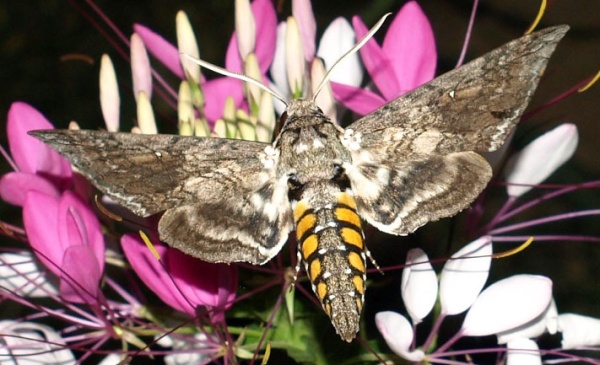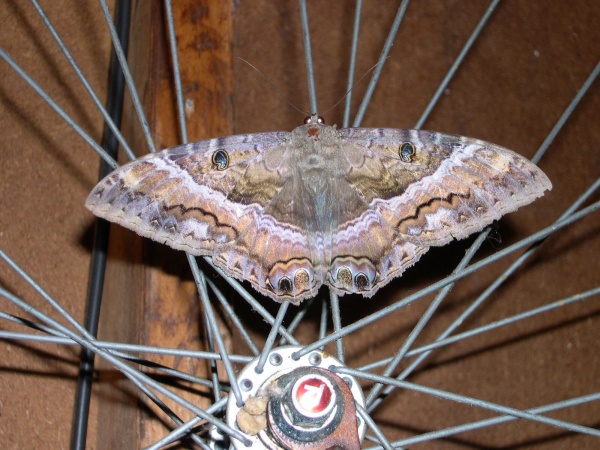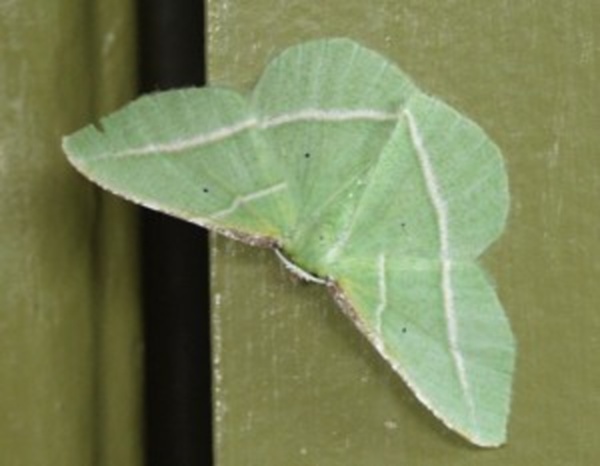Setting the record straight about the butterfly’s lesser respected cousin, National Moth Week (July 18-26) was created to raise awareness of the unique biodiversity of these winged wonders.
Here in Los Angeles, moth-gawkers will be out this week to catch a glimpse of these ‘furry’ flyers. Here’s a short primer on five local lepidropteric luminaries:
Black Witch Moth
A real show-stopper, this large 6-inch moth hails from Mexico and South America but has been known to hang out in Los Angeles neighborhoods. In addition to the spectacular markings and size, the moth is surrounded by superstition. In Jamaica, they are seen as the embodiment of a lost soul; Bahamians consider them Money Moths, which predict good fortune. In some parts of Mexico, people joke that if a black witch flies over your head, you will lose your hair.
Black Witch Moth/What’s That Bug?
Walnut Underwing Moth
This striking moth is study in contrasts. Its hindwings are muted colors in a tree-like pattern, but the upperside is where the action is. You usually don’t see this moth’s color when they are resting since it’s hidden under their dull forewings – but if a predator (birds, bats) comes by, the moth will suddenly flash open its hindwings and that burst of color often scares off the hungry. It’s a good thing, since this moth isn’t bad-tasting or poisonous. All it has to defend itself is its ab-fab hue.
Underwing Moth/What’s That Bug?
Tobacco (or Carolina) Sphinx Moth Often confused for a bird, this moth has often been called the hummingbird moth because of its remarkable ability to hover as it wanders from plant to plant. This furious flyer is impressive in size (can be up to 3 ½ inches wingspan) and dines on a selection of host plants including tobacco and tomato plants. Indeed, when it’s in it larvae stage it’s often confused tomato hornworms, those giant green buggers that can terrorize gardeners and desiccate tomato plants.

Carolina Sphinx Moth/What’s That Bug?
Mexican Tiger When your kid brings home a woolly bear caterpillar, they’ve probably brought home a larvae of this colorful moth. While the fuzzy larvae are fun, when these critters put on their wings, you’ll see a moth with some of the most beautiful geometric markings around.
Mexican Tiger Moth/What’s That Bug?
Emerald Moth Straight from Oz’s Emerald City, these green-laden moths have many subspecies featuring red or frilly edges on their wings, white lines or black dots patterns on their surface wings. Lumped into the handy category of “Emeralds,” these moths were introduced from Europe and they have, flutter by flutter, been expanding their range in North America on a conquest to be the greenest moth around.
Emerald Moth/What’s That Bug?
Moth Facts:
- Moths are among the most diverse and successful organisms on earth.
- Scientists estimate there are 150,000 to more than 500,000 moth species.
- Their colors and patterns are either dazzling or so cryptic that they define camouflage. Shapes and sizes span the gamut from as small as a pinhead to as large as an adult’s hand.
- Most moths are nocturnal, and need to be sought at night to be seen – others fly like butterflies during the day.
- Finding moths can be as simple as leaving a porch light on and checking it after dark. Serious moth aficionados use special lights and baits to attract them
By Brenda Rees, editor
Featured Image is of a white-lined sphinx moth/What’s That Bug?




